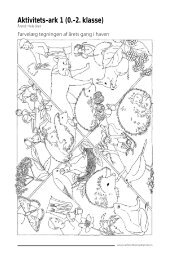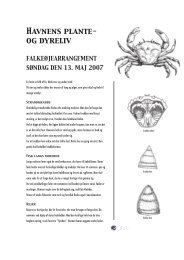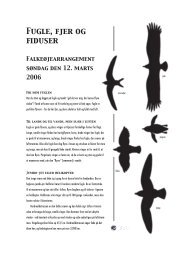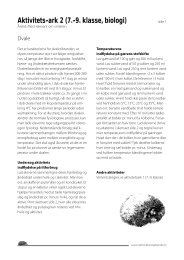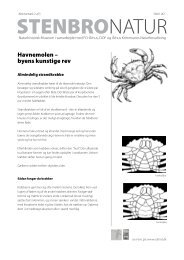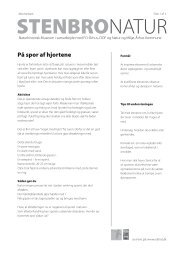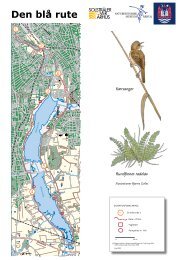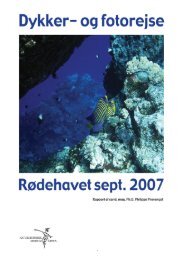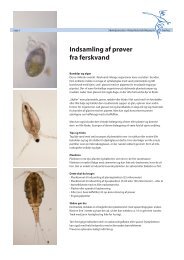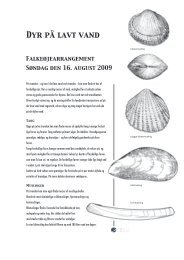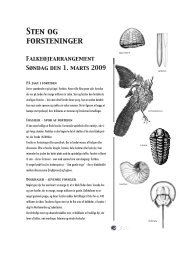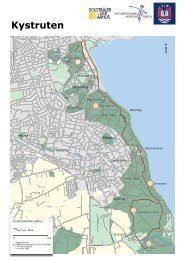En analyse af gylp fra hvid stork Ciconia ciconia i Danmark
En analyse af gylp fra hvid stork Ciconia ciconia i Danmark
En analyse af gylp fra hvid stork Ciconia ciconia i Danmark
Create successful ePaper yourself
Turn your PDF publications into a flip-book with our unique Google optimized e-Paper software.
Summary<br />
Food contents in pellets<br />
of White Stork <strong>Ciconia</strong><br />
<strong>ciconia</strong> in Denmark<br />
1976-2003<br />
Natural History Museum in Aarhus has<br />
investigated 362 pellets from Danish<br />
White Stork, collected during the period<br />
1976-2003 by Hans Skov, especially from<br />
Southern Jutland (several locations),<br />
NW-Jutland (Vesløs, Vang) and NE-<br />
Jutland (Vegger) . All of the 362 pellets<br />
were <strong>fra</strong>gmented and analyzed for the<br />
content of vertebrate bones, earthworm<br />
bristles, sand and pebbles, whereas a<br />
representative sample, consisting of 123<br />
pellets from eight main locations, was<br />
further analyzed for remains of insects<br />
and other small organisms .<br />
The analysis showed that earthworms,<br />
estimated from both bristle and sand<br />
content, constituted a very large<br />
amount of the remains in the pellets,<br />
calculated as fresh weight on average<br />
approx . 77% of the biomass in the<br />
analyzed sample . Mammals and birds,<br />
especially mole (Talpa europaea), field<br />
vole and common vole (Microtus agrestis,<br />
M. arvalis), were few in numbers, but<br />
averaged approx . 16% of the calculated<br />
biomass, while a large number of insects<br />
(and a few mollusks), especially Carabidae,<br />
Dytiscidae, Silphidae, Geotrupidae,<br />
Aschnidae, Acrididae and Tipulidae, averaged<br />
only approx . 7% of the calculated<br />
biomass (fig . 12, p . 19) .<br />
Amphibians, often considered important<br />
food items of the White Stork, could<br />
hardly be traced, probably because their<br />
bones are dissolved by the stomach acid<br />
of the <strong>stork</strong> . However, the remains of<br />
very small insects, especially numerous<br />
in pellets from Vesløs, indicate that such<br />
<strong>stork</strong>s have consumed amphibians,<br />
assuming that the small insects were<br />
primarily ingested by these amphibians .<br />
In case a <strong>stork</strong> predominantly feeds on<br />
amphibians fewer and smaller pellets<br />
will be produced, and urea and the microscopic<br />
bristles will to a higher extent<br />
be excreted by the vent (Cloaca) . Sand,<br />
primarily from digested earthworms, will<br />
still be disgorged and thus occur in a<br />
higher ratio compared to bristles than in<br />
other pellets . This was actually the case<br />
in Vesløs, but still it is difficult to estimate<br />
the amphibian biomass on this basis .<br />
Given the very irregular sampling<br />
practices it is difficult to draw definitive<br />
conclusions, but compared to previous<br />
Danish studies (Skovgaard, 1920) it seems<br />
evident that the White Storks used<br />
to consume more large insects (Carabus,<br />
Dytiscus, Geotrupes) than recently, when<br />
predominantly medium sized insects<br />
(Pterostichus, Silpha) were taken, presumably<br />
because several of the larger<br />
insect species have declined or become<br />
locally extinct . Also, amphibians and<br />
small mammals have become scarce<br />
in the cultivated Danish landscape and<br />
the large proportion of earthworms<br />
in the analyzed pellets indicate that<br />
earthworms gradually became the main<br />
food ressource of the Danish <strong>stork</strong>s .<br />
Recent studies in Germany and Poland<br />
5<br />
(Dziewiaty & Schulz, 1998; Tryjanowski<br />
& al ., 2006) suggest that these populations<br />
to a much higher degree prey on<br />
mammals, amphibians or insects, as the<br />
habitats still provide these food items .<br />
Following several decades of decline<br />
the White Stork ceased breeding in Denmark<br />
around the turn of the millennium .<br />
One of the last nesting sites was Vesløs,<br />
still a good habitat, but now extremely<br />
isolated from the closest breeding<br />
population . The last breeding site was<br />
Ribe in SW-Jutland, where the habitat<br />
was gradually spoiled, but the <strong>stork</strong>s<br />
survived from fishing in trout farms .<br />
However, since then a few breeding<br />
attempts have been made on Zealand<br />
by semi-domesticated <strong>stork</strong>s originating<br />
from Sweden . Moreover, many White<br />
Storks still breed in NW-Germany, close<br />
to the Danish border, thus making it<br />
likely that the species could return as a<br />
breeding species if habitat conditions<br />
improve .


